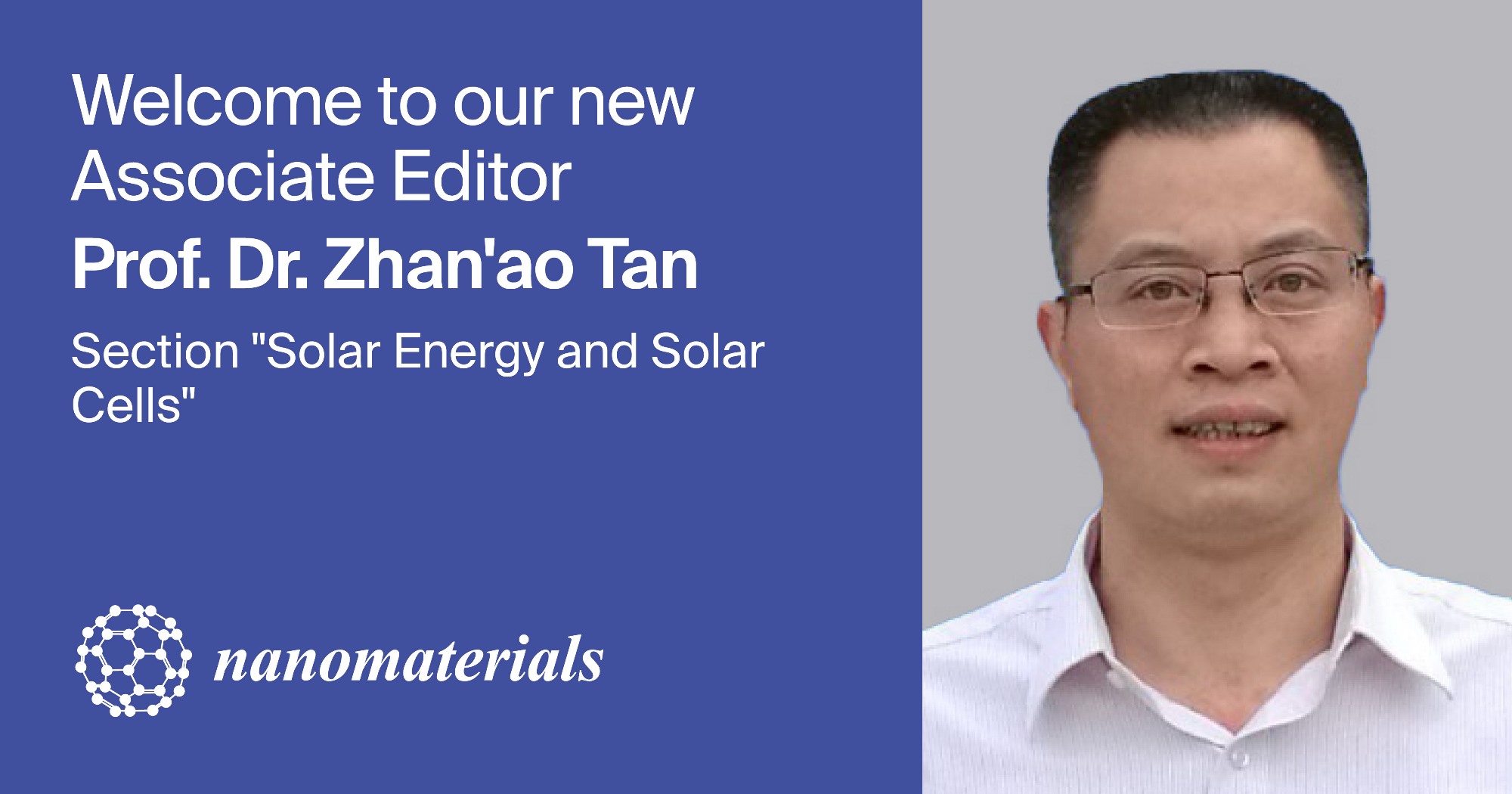
Prof. Dr. Zhan’ao Tan Appointed Associate Editor of Section “Solar Energy and Solar Cells” in Nanomaterials
We are pleased to announce that Prof. Dr. Zhan’ao Tan has been appointed Associate Editor of the Section “Solar Energy and Solar Cells” in Nanomaterials (ISSN: 2079-4991). With an extensive background in scientific research and publishing, he will bring a wealth of knowledge and expertise to this role.
Name: Zhan’ao Tan
Affiliation: Beijing Advanced Innovation Center for Soft Matter Science and Engineering, Beijing University of Chemical Technology
Interests: materials and devices for novel thin film solar cells (polymer solar cells and perovskite solar cells); materials and devices for novel light-emitting diodes (quantum dots light-emitting diodes, perovskite light-emitting diodes, and carbon dots light-emitting diodes); materials and devices for energy storage (organic redox flow batteries)
Website: https://en-baicsm.buct.edu.cn/2019/0703/c807a22296/page.htm
The following is a short Q&A with Prof. Dr. Zhan’ao Tan, who shared his vision for the journal with us, as well as his views on the research area:
1. You have conducted a substantial amount of fundamental scientific research in the field of organic optoelectronic materials and devices. What do you think are the imminent bottlenecks that need to be overcome for these technologies to move from laboratory experiments to industrial applications?
Organic optoelectronic materials and devices represent an emerging research field formed at the intersection of disciplines such as chemistry, physics, materials science, and information electronic science. In particular, organic optoelectronic materials constructed with organic conjugated molecules, colloidal quantum dots, and organic–inorganic hybrid perovskites exemplify potential applications in various areas such as novel flat panel displays, solid-state lighting, new energy sources, photochemistry, high-density information transmission, and storage devices. These materials manifest a wide range of application prospects and have garnered close attention from both academic and industrial communities.
For instance, organic light-emitting diodes (OLEDs) exhibit advantages such as active luminescence, rich color rendering, full solid state, and feasibility for flexible displays, which makes them considered as one of the most promising new flat panel display technologies. These OLEDs have gradually been implemented in large-scale production globally. Additionally, organic and perovskite solar cells are low in cost, simple in fabrication, and easily scalable to large-area devices, showcasing significant potential as a renewable energy technology with their photovoltaic conversion efficiencies approaching practical requirements.
However, organic optoelectronic devices still face a number of pending issues concerning materials, efficiency, lifespan, color rendering, large dimensions, flexibility, encapsulation, and production processes, which to a certain extent hinder the industrial development of organic optoelectronic devices. Therefore, future research directions will revolve around materials, devices, and mechanisms, forming a complete R&D chain encompassing “material design synthesis–high-performance device fabrication–device physical mechanism–technological dissemination and application”, aimed at breaking through key technologies such as large-area, flexible, and batch production processes, thus realizing the industrial application of research achievements.
2. With over 250 SCI-indexed papers published in international journals and more than 15,000 citations, how do you maintain innovation and consistently produce high-quality papers in academic research?
In my view, maintaining innovation and continuous high-quality output first requires a comprehensive understanding of the research field. This involves extensively reading the latest literature and classic works in the relevant field, participating in academic seminars, and engaging in discussions with scholars to swiftly grasp the latest research advancements in the field. Secondly, it entails conducting a rational analysis of the current state of research, identifying its shortcomings and limitations, and pinpointing potential research directions and breakthroughs. Finally, it involves proposing new questions or hypotheses based on existing research and designing experiments or research methods to validate or explore these questions or hypotheses. Through the integration of theory and practice, in-depth analysis of research results, and the discovery of new issues, one can present novel insights.
3. What expectations and goals do you have in your role as Associate Editor of the “Solar Energy and Solar Cells” Section?
About two years after serving as a member of the Editorial Board of Nanomaterials, I received an invitation from the journal office to become the Section Associate Editor. Given our positive past collaborations on Special Issues and other journal management tasks, I am pleased to accept this new opportunity. I hope to use my more than 20 years of professional knowledge and experience to participate more in the establishment of journals and Sections, to capture research hot spots and trends in academia, and to ensure the high-quality development of journals.
Nanomaterials is an authoritative academic journal focusing on the field of nanomaterials research. The responsibility and importance of being the Associate Editor of the Section are self-evident. As a Section Associate Editor, I believe that the most important quality is to have keen academic insight, as well as excellent communication and organizational coordination skills. I will continue to learn and practice in this position to promote the development of the journal.
We warmly welcome our Associate Editor, Prof. Dr. Zhan’ao Tan, and wish the journal every success in the future.